Listen to episode 2
THE ORIGIN OF MINT IN GREEK MYTHOLOGY
In Greek mythology, the goddess Persephone suspected her husband Hades, god of the underworld, of having an affair with a nymph called Minthe. In a jealous rage, she transformed the lovely nymph into a perennial herb. Hades, unable to counteract his wife’s spell, bestowed Minthe with a sweet smell so that she would continue to delight those who came in contact with her.
Another version of the myth says that it was not Hades, but Pluto, the Roman god of wealth and the underworld, who had a crush on Minthe. It was Pluto’s wife, Proserpina who was jealous of Minthe and turned her into a plant. Pluto then gave Minthe the same gift of a pleasant aroma.
The transformation of Minthe into a herb serves as a cautionary tale about the destructive power of jealousy and the enduring nature of beauty.
This narrative is depicted in the painting titled “Menthe changed into a Mint Plant” by Johann Ulrich Krauss created in 1694 portraying Minthe’s transformation into a mint plant as a punishment for her involvement with Hades.
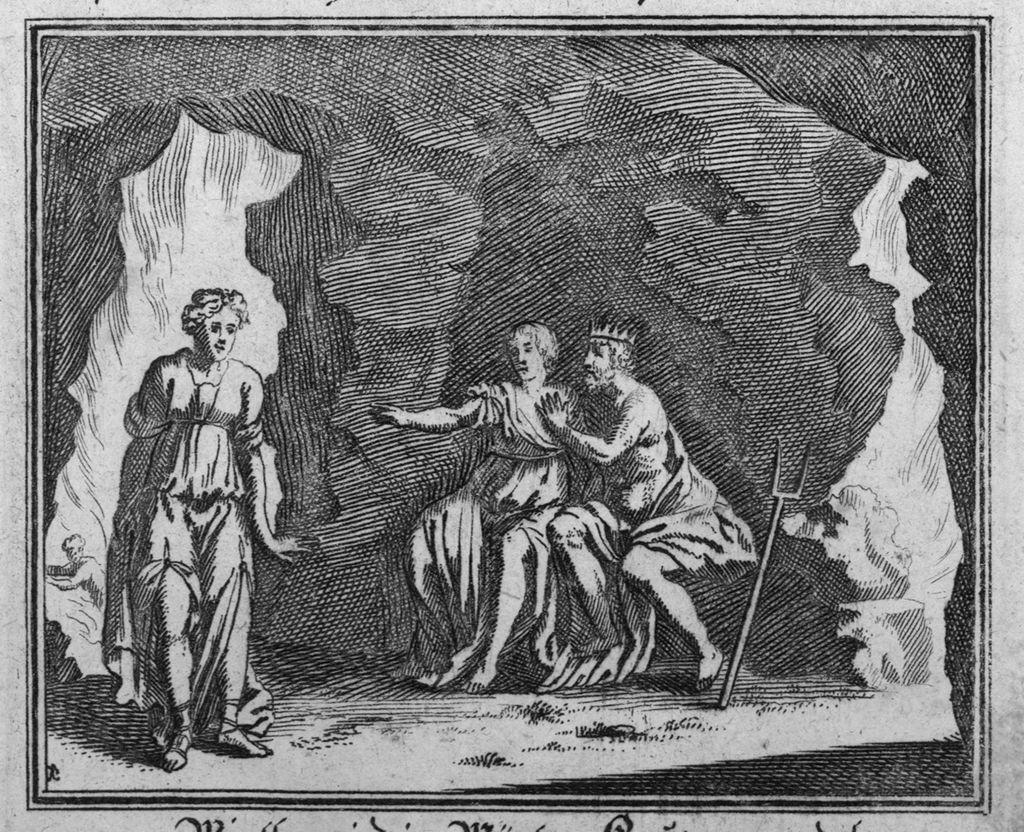
Minthe wird in Münzen Kraut verwandelt by J. U. Krauss (1694); Source: jstor.org
MINT: THE HERB OF FUN AND HOSPITALITY
The Romans and Greeks commonly crowned themselves with it and decorated tables with the herb at their parties.
The ancient Romans used mint as a scented adornment for their tables at their parties and even crowned themselves and their guests with garlands made of mint. They also used to spread mint on floors in their homes for freshness. These gave off a slight scent where they were scattered, and ‘when they were trampled on, a strong and pleasant aroma scented the place.
Pliny The Elder recorded that the Greeks and Romans made great use of mint, adding it to both bathwater and perfumes, while also using it in sauces and wines.
Although many types of aromatic plants served this purpose, mint was preferred over alternatives owing to its stronger effect.
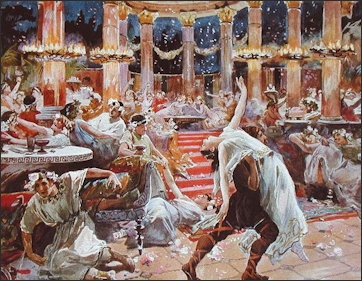
Banquet at emperor Nero’s palace; Source: factsanddetails.com
MINT USED IN BABYLONIAN HEALING RITUALS
The oldest written records of mint herbs are attributed to King Hammurabi of ancient Babylon, who prescribed them for medicinal purposes, namely gastrointestinal.
In a list of Babylonian healing rituals, pharmaceutical components such as cress, mint, extract of cedar, and date palm, were used in conjunction with invocations. he Babylonian Talmud, which contains teachings on various subjects, including medical advice, also mentions these rituals.
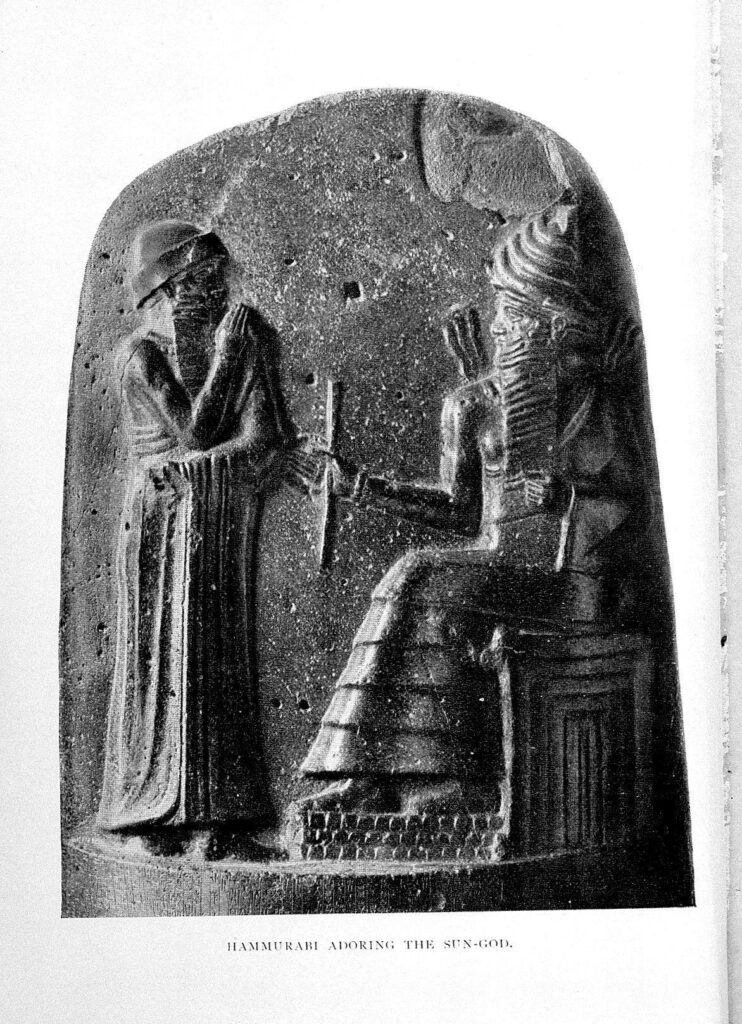
The Hammurabi Code; Source: jstor.org
ANCIENT EGYPTIANS INVENTED WORLD’S FIRST BREATH MINT?
Ancient Egyptians had bad dental health because of their unbalanced diet and the use of stones to grind flour, which led sand to get into their food and wear down their teeth.
They didn’t have access to good dental care like we do now, leading to overall poor oral health. To combat bad breath from decaying teeth, they used a mixture of herbs and spices like frankincense, myrrh, and cinnamon boiled together with honey to make pellets – similar to ancient mints but probably not as tasty as today’s mint.
Next time you reach for a mint, think about the ancient Egyptians who first came up with this clever solution for dental issues
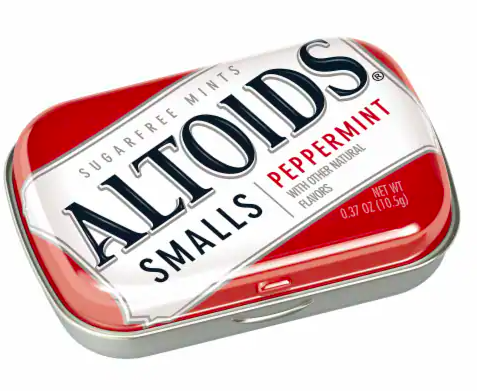
Mint brand invented by Smith & Company in 1780s; Source: wikipedia
mint weaves itself into the fabric of early Christianity
In Slavic, Latin, and Teutonic languages, there’s a famous story about Virgin Mary and Baby Jesus. According to the tale, Mary fled with Baby Jesus from King Herod’s soldiers.
She met a peasant while seeking help. He advised them to hide behind a small mint plant which miraculously spread but couldn’t completely conceal them.↵Mary then asked the peasant to leave his plough on the ground. Suddenly, young wheat seedlings sprang up unexpectedly high.
When pursued by soldiers looking for her carrying a baby, he said she had passed by when he was sowing seeds. The pursuers believed it was too late to catch up with her and abandoned the chase

Mary feeding Jeses; Source: jstor.org
Mint and women’s health in Medieval times
In the Middle Ages, many women resorted to herbal remedies to end a pregnancy in its early stages. This knowledge was passed down from mothers, community herbalists, midwives, and local healers. To terminate an unwanted pregnancy, women tried cold footbaths, bloodletting, or consuming artemisia or mint tea.
John M Riddle, a well-known American historian and expert on medical history, has stated that people living in medieval times had a greater sense of control over their lives than we may have originally believed.
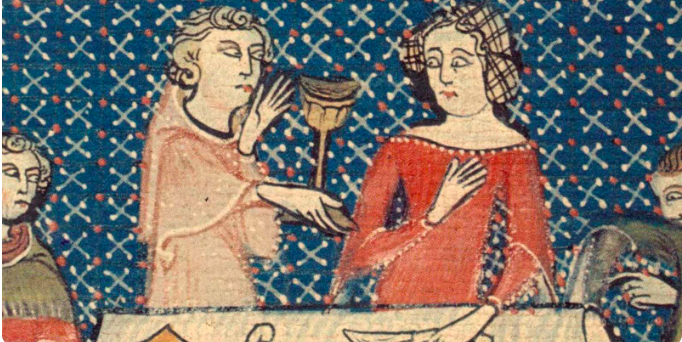
Source: Unknown, Wikimedia commons; public domain
MINT MISADVENTURES WITH MRS. CRUPP
In the book David Copperfield by Charles Dickens, Ms. Crupp is the landlady of the place that David rents when he works in London. She drinks a lot and often takes David’s alcohol without permission. Mrs. Crupp suffered from a strange condition called ‘the spazzums’ that caused nose inflammation and required constant peppermint treatment.

Still from David Copperfield movie (1999); Source: imdb
THE PEPPERMINT STAMP OF DDR
The “Peppermint Stamp” from the German Democratic Republic is a unique postage stamp issued in East Germany in 1959. It features a vibrant design depicting peppermint leaves and flowers, symbolizing agricultural achievements during the DDR’s Five-Year Plan. The stamp reflects the government’s emphasis on economic goals and self-sufficiency in food production.
Today, it holds historical significance and represents DDR’s economic policies during the Cold War era.
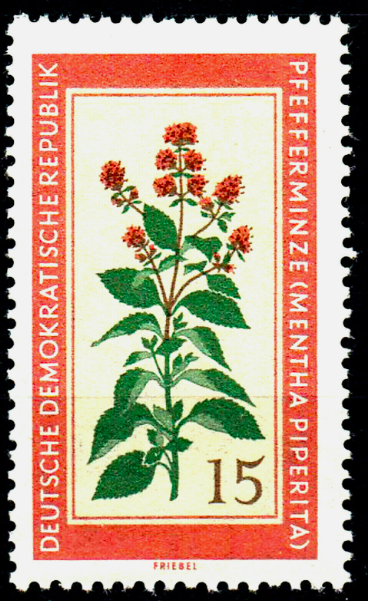
DDR’s peppermint stamp; Source: Stampcommunity.org
ME, MAHMOUD & THE MINT PLANT
A Canadian nurse works as a humanitarian aid worker in war-torn Iraq and uncovers the story behind her colleague Mahmoud, who brings his mint plant to work with him every day. It is a tale of promises, heritage, and the enduring bond between people and their homeland.
Watch the short documentary here: YouTube
POTENTIAL MEDICINAL BENEFITS OF MINT
In addition to its traditional culinary and home remedy uses, mint also possesses potential health benefits such as antimicrobial, antiviral, and anti-inflammatory properties. These effects are attributed to the bioactive compounds found in essential oils of mint, with menthol being the primary constituent. The essential oil extracted from fresh or partially dried herbs is utilized for enhancing the flavor of confectionery items, chewing gums, liqueurs, toothpaste, mouthwashes, and pharmaceutical preparations.
Scientific research indicates that mint may offer advantages for individuals with irritable bowel syndrome and related digestive issues by providing analgesic and respiratory effects. Furthermore, mint essential oil may aid in alleviating pain associated with menstrual cramps and muscle discomfort.
When used in conjunction with aromatherapy practices, mint oil has demonstrated positive impacts on mental health by promoting relaxation, stress reduction, and mood enhancement. Although employing essential oils for improving mental well-being follows a holistic approach, it is advisable to seek guidance from a qualified healthcare professional or aromatherapist first especially if you have existing medical conditions or take medication.
A 2023 experimental study revealed that mint oil can improve memory and may be beneficial in enhancing memory among individuals affected by Alzheimer’s disease. Moreover, recent studies have also presented promising findings regarding the treatment of lung and breast cancer.
REFERENCES:
1.https://www.greekmythology.com/
2.https://www.history.com/topics/ancient-greece/greek-mythology
5. https://pubmed.ncbi.nlm.nih.gov/
7. Al-Tawarah NM, Al-dmour RH, Abu Hajleh MN, Khleifat KM, Alqaraleh M, Al-Saraireh YM, Jaradat AQ, Al-Dujaili EAS. Rosmarinus officinalis and Mentha piperita Oils Supplementation Enhances Memory in a Rat Model of Scopolamine-Induced Alzheimer’s Disease-like Condition. Nutrients. 2023; 15(6):1547. https://doi.org/10.3390/nu15061547
8. Murugesh, V., Shetty, D., Kurmi, A., Tirlotkar, S., Shetty, S., & Solanke, S. (2024). A comprehensive review of essential oils for depression management. Journal of Pharmacognosy and Phytochemistry, 13(2), 60-70.
9. Dolghi, A., Coricovac, D., Dinu, S., Pinzaru, I., Dehelean, C. A., Grosu, C., Chioran, D., Merghes, P. E., & Sarau, C. A. (2022). Chemical and Antimicrobial Characterization of Mentha piperita L. and Rosmarinus officinalis L. Essential Oils and In Vitro Potential Cytotoxic Effect in Human Colorectal Carcinoma Cells. Molecules (Basel, Switzerland), 27(18), 6106. https://doi.org/10.3390/molecules27186106
10. Hardinge, H., & Going, C. B. (1938). An Old-World Folk-Tale. Folklore, 49(3), 290–291. http://www.jstor.org/stable/1257471
11. Barbara Böck, “When You Perform the Ritual of ‘Rubbing’: On Medicine and Magic in Ancient Mesopotamia,” Journal of Near Eastern Studies 62 (2003): 7-8.
12. Cunningham’s Encyclopedia of Magical Herbs | Leafy Medicinal Herbs: Botany, Chemistry, Postharvest Technology and Uses
13. van de Walle, E. (1997). Flowers and Fruits: Two Thousand Years of Menstrual Regulation. The Journal of Interdisciplinary History, 28(2), 183–203. https://doi.org/10.2307/206401
15. Hardinge, H. (1938). An Old-World Folk-Tale. Folklore, 49(3), 290–291. https://doi.org/10.1080/0015587X.1938.9718771
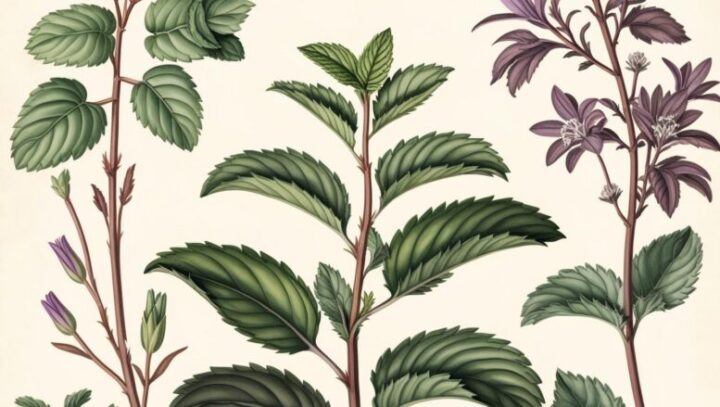
Leave a Reply